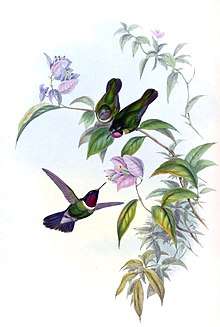Longuemare's sunangel
Longuemare's sunangel (Heliangelus clarisse) is a hummingbird found in Venezuela and northeastern Colombia.[2] It is closely related to the amethyst-throated sunangel, and species limits in this complex are unclear.[3] The American Ornithological Society has not recognized the split.
| Longuemare's sunangel | |
|---|---|
 | |
| Scientific classification | |
| Kingdom: | Animalia |
| Phylum: | Chordata |
| Class: | Aves |
| Order: | Apodiformes |
| Family: | Trochilidae |
| Genus: | Heliangelus |
| Species: | H. clarisse |
| Binomial name | |
| Heliangelus clarisse Longuemare, 1841 | |
| Synonyms | |
| |
Distribution and taxonomy
In the Handbook of the Birds of the World,[4] Longuemare's sunangel is one of the four subspecies of the amethyst-throated sunangel: Longuemare's sunangel, H. c. clarisse in the Colombian Andes from Norte de Santander to the latitude of Bogotá; violiceps in the Sierra de Perijá (only in Zulia in Venezuela); H. c. verdiscutus in southeastern Norte de Santander, Colombia, and southern Táchira, Venezuela; and Mérida sunangel, H. c. spencei isolated in Mérida, Venezuela.[2][5] The IOC continues to recognize both the Mérida sunangel and Longuemare's sunangel..
Description
This bird is 9.4 cm (3.7 in) long (not including the bill) and weighs 5.3 grams, on average. The bill is short for a hummingbird—1.8 cm or 0.7 in long. The overall impression is of dark plumage.[2]
Males are dark green above except that the crown is dull green. They have a narrow, glittering blue "frontlet" above the bill. Behind the eye is a bold white spot. They have a glittering pinkish-purple throat above a white crescent crossing the chest. The rest of the breast and belly is shining dark green mixed with gray. The undertail coverts are white. The tail is long and broad, bronze-green to blackish, with tiny white tips on the two outer feathers. Females resemble males but are duller, and white feather bases may show in the throat.[2][5]
Habitat
It inhabits forests, especially edges and openings, as well as brushy pastures[2] and damp ravines with bushes;[5]
Behavior
Longuemare's sunangel generally flies and perches fairly low. Along forest edges with rich patches of flowers such as Psammisia and similar plants of the heath family, it behaves territorially. However, within forests, it flies along "trap-lines" from one flowering vine, epiphyte, or shrub (such as Palicourea) to the next. It feeds on nectar by hovering in front of flowers or clinging. In addition, it occasionally catches airborne insects in short flights. It feeds actively in the midst of mixed-species flocks when they pass.[2]
References
- BirdLife International (2014). "Heliangelus clarisse". IUCN Red List of Threatened Species. 2014. Retrieved 9 September 2015.CS1 maint: ref=harv (link)
- Hilty, Steven L. (2003), Birds of Venezuela, Princeton University Press, p. 426, ISBN 0-691-09250-8
- Stiles, Gary (November 2004), Split Heliangelus clarisse from H. amethysticollis, archived from the original on 2006-09-04, retrieved 2007-10-07. A proposal to continue to consider this species part of H. amethysticollis pending further study, with unanimous agreement from six other ornithologists.
- Schuchmann, K. L. (1999), "Family Trochilidae (Hummingbirds)", in del Hoyo, J.; Elliott, A.; Sargatal J. (eds.), Handbook of Birds of the World, Volume 5: Barn-owls to Hummingbirds, Barcelona: Lynx Edicions, pp. 468–680, ISBN 84-87334-25-3
- Hilty, Steven L.; Brown, William L. (1986), A Guide to the Birds of Colombia, Princeton University Press, p. 66, ISBN 0-691-08371-1, retrieved 2007-10-06
